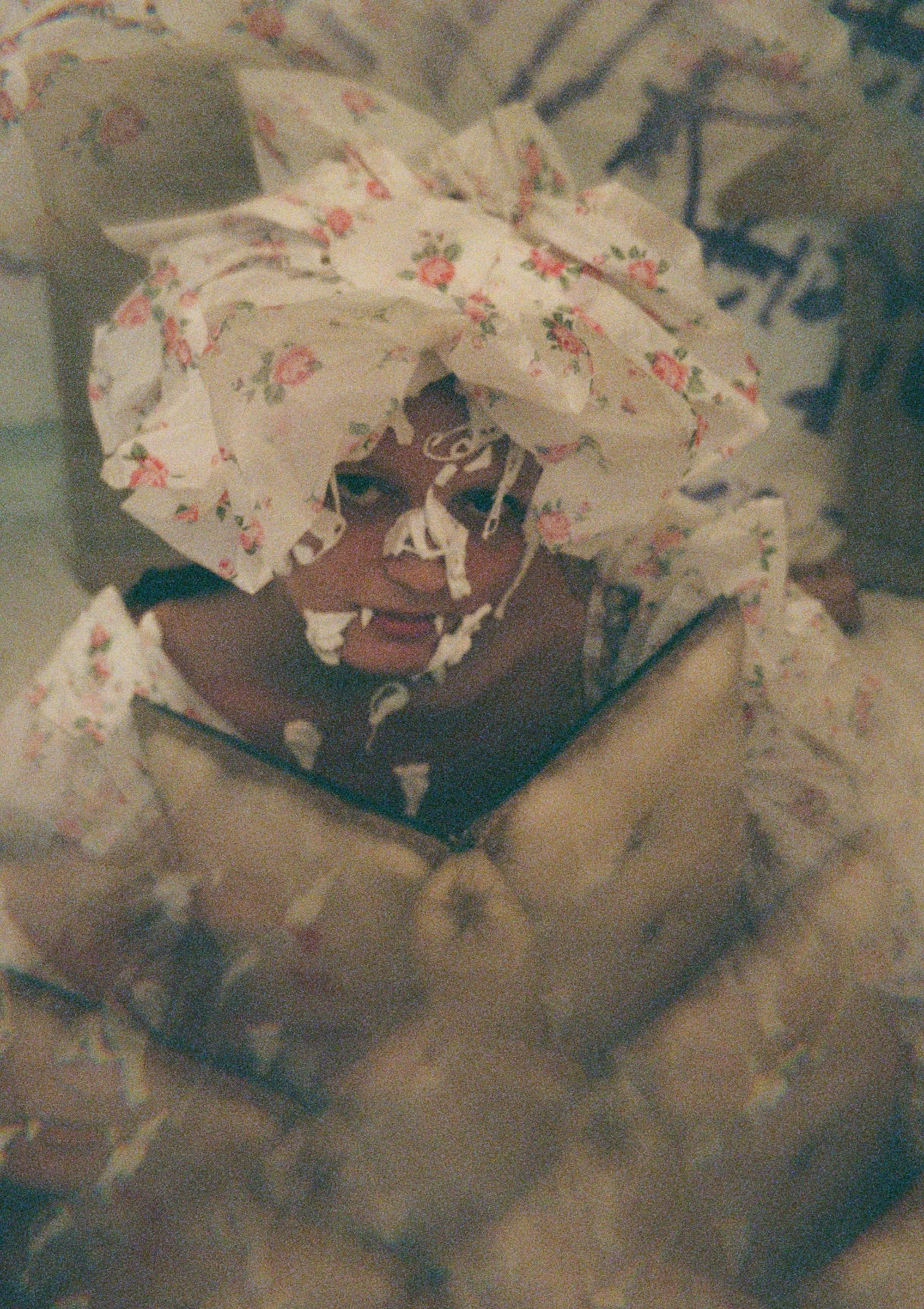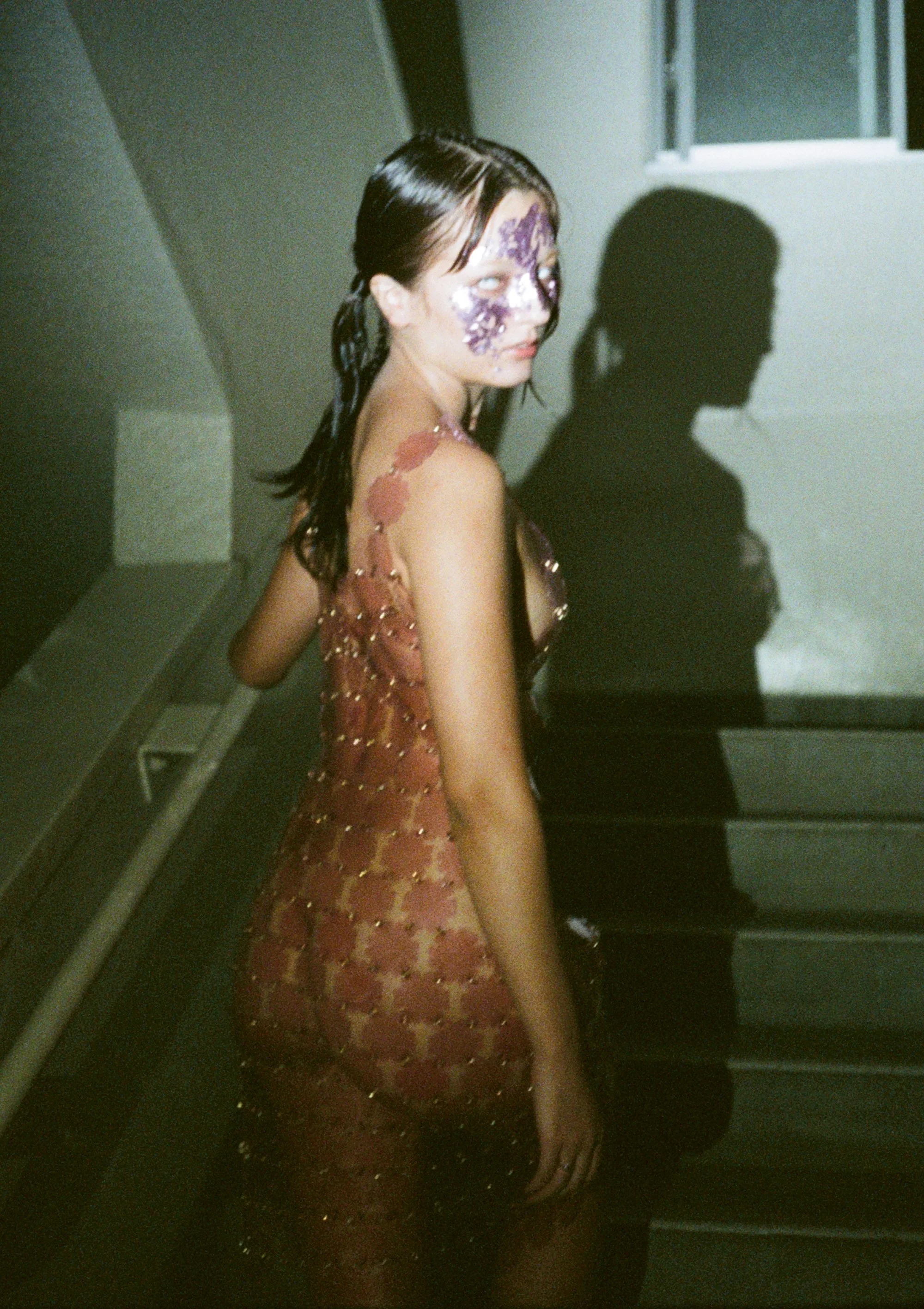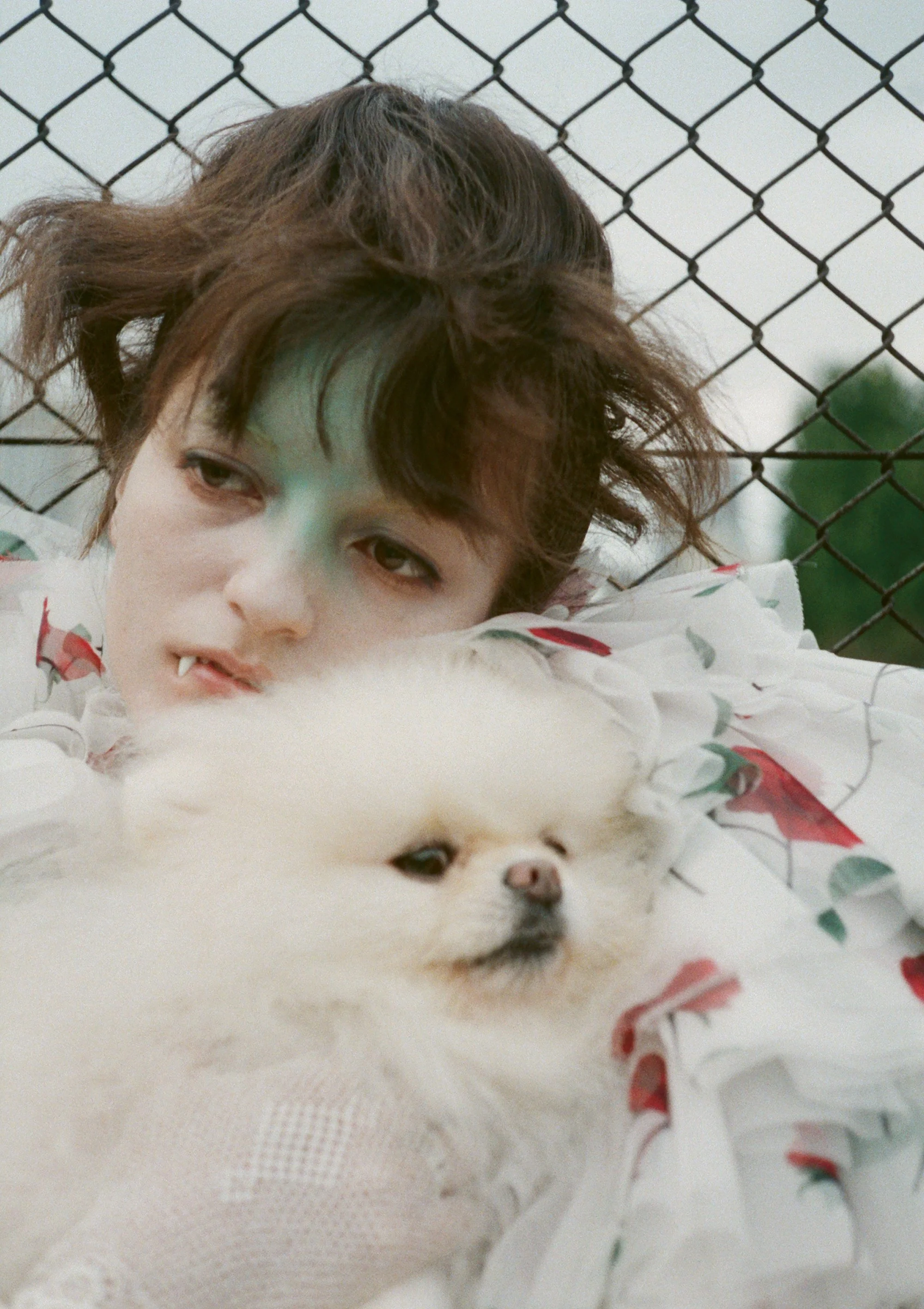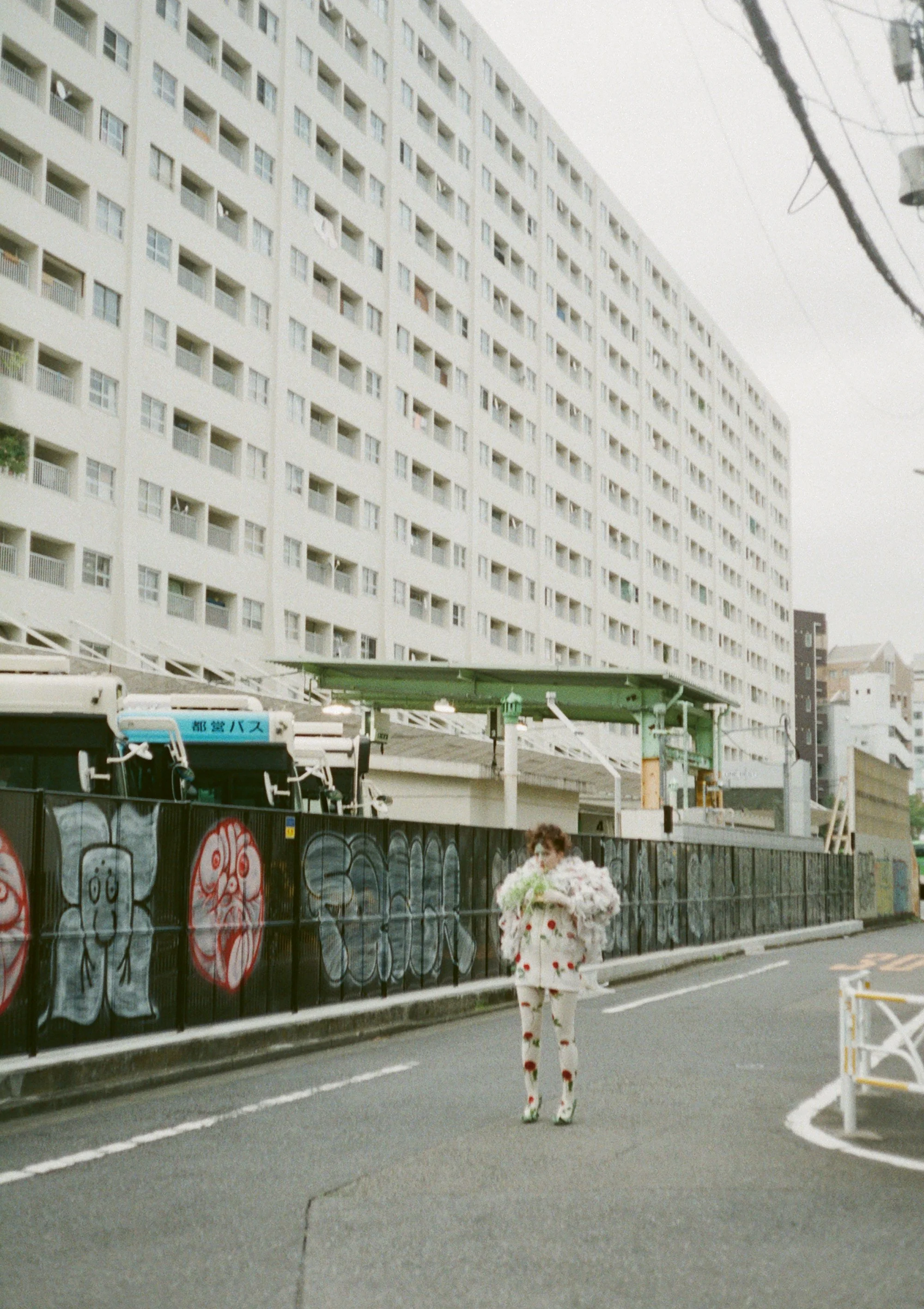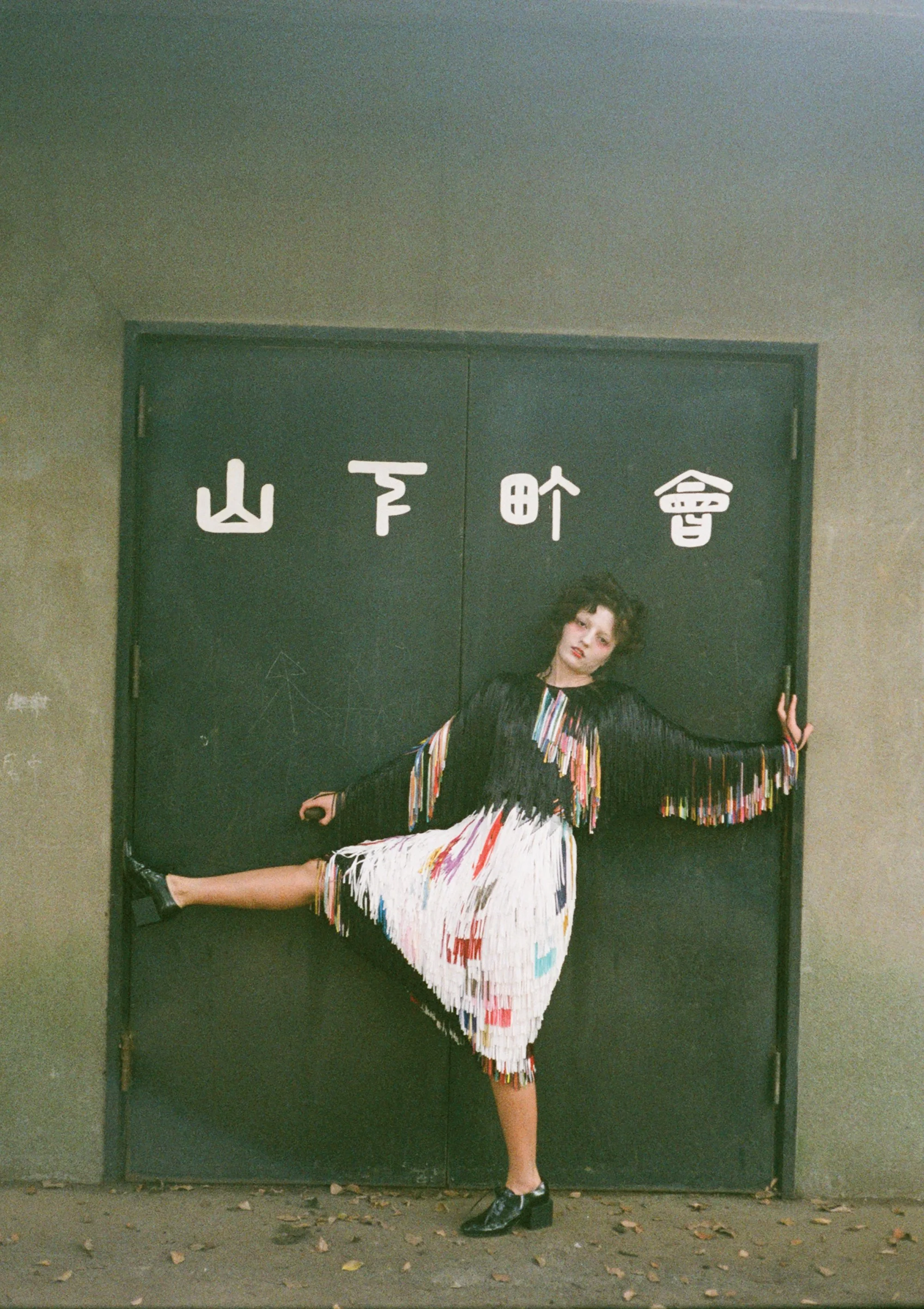Who is Hanayo ?
Who is Hanayo ?
A conversation with Hanayo
Photographs by
Hanayo
Interview by
Makoto Kikuchi
The question, “Who is Hanayo?” is impossible to answer in just a few words. Born in Tokyo in 1970, Hanayo has been a model and a singer since high school, appearing in TV commercials and magazines. By the time she turned 20, she had made her debut as a hangyoku (半玉 — geisha in training) in Mukojima, Tokyo, serving sake to artistic luminaries such as Yayoi Kusama, Leos Carax, and Dennis Hopper. While working as a junior Geisha, she also performed as a model and singer, and her unique character drew the attention of domestic and foreign media. In the mid-‘90s, she became a well known cultural icon and was featured on the cover of the British magazine The Face, as well as in a campaign for French fashion designer Jean Paul Gaultier.
After moving to England in 1995 and giving birth to her daughter, Tenko in 1996, Hanayo met German theatre director Christoph Schlingensief with whom she performed with for several pieces. In 1999, Hanayo and Tenko moved to Berlin where she built a close relationship with local artists and musicians. While also a geisha, musician, performer, and mother, Hanayo is primarily known as a photographer in Japan. She began taking photographs at the age of 13 and published her first photobook Hanayome (1996), highly praised by some of Japan’s most renowned photographers such as Nobuyoshi Araki and Daido Moriyama. In 2011, Hanayo and Tenko moved back to Japan, where they currently live.
Dress PACO RABANNE
Vintage shoes COACH
Makoto Kikuchi: Could you tell me something about your childhood — what kind of child were you, and what was your family like?
Hanayo: I believe everyone grows up thinking that their home is normal. Then, when you look at other people’s families, you’ll be like, “Wow, my family was strange.” That was the case for me too. My father was a chemistry researcher, and he had a somewhat similar personality to mine: he was very dedicated to his research. Sometimes he would come home to find his hair burnt or his eyebrows missing, but no one would laugh at him though it honestly was very funny. My brother was quite particular about things and also had various tics. When he was little, he developed a phobia towards rhombuses: in 1970, he visited the World Expo in Osaka; Mitsubishi’s exhibition hall was full of diamond-shaped patterns, and as soon as he saw that, he started foaming at the mouth and fell over. Since then, he would fall over just by seeing any sort of diamond shape, even on a Japanese sliding door. So I considered myself the “normal” one of the family, however my teachers didn’t think the same. I was labeled “hyperactive” and “accident prone” due to my clumsiness, like walking into sign posts and bleeding from my head. My parents actually complained about that label to my school.
MK: Growing up, what were you attracted to the most?
H: Ever since I was little, I have been attracted to things from the past: for instance, when I was in the first or second grade of elementary school, I used to love watching reruns of anime from the late ‘70s, such as Humanoid Monster Bem, and Tiger Mask. Of course, there was no YouTube back then, so I would record them on VHS and sing the opening themes. I would also record my performance on cassette tapes. I also used to re-enact Japan’s longest-running TV talk show, Tetsuko no Heya (translated as Tetsuko’s Room), with a friend of mine, changing the title to Hanayo no Heya (Hanayo’s Room). We actually made about a hundred audio recordings of it. Looking back, I guess I was pretty weird as a kid.
MK: You have also worked as a singer. What kind of music were you influenced by?
H: I bought my first record in elementary school, by The Plastics, a Japanese new wave band from the late ‘70s. There were other electronic music bands like Yellow Magic Orchestra, but The Plastics were the most unique. They had a girl vocalist, with interesting cover art and music videos. I even begged my mother to take me to one of their concerts. Everyone else at school liked male J-pop idols, so maybe my taste was a little mature for my age. I discovered music through my brother’s magazines and from listening to Sound Street (1978-1987), an NHK-FM radio show where the “Professor” (Ryuichi Sakamoto’s nickname in Japan) DJ’ed every Tuesday.
MK: In 1992, you started a noise band called Muscats and a few years after, you moved to Europe to pursue your passion for punk. What made you fall in love with the culture?
H: I got into punk culture in middle school. Honestly, back then, I didn’t know about music genres’ classification as much as I do now, so I wasn’t really the “I only listen to punk”-type of girl. However, growing up in Nakano, I had constantly been exposed to Tokyo’s punk scene: in my neighbourhood, there was this noise band called Hanatarash, often hosting infamously dangerous live performances where they did crazy stuff, like destroying the venue with a backhoe bulldozer. By the time I entered high school, there were lots of cool Japanese noise bands such as Nagomu Record, G.I.S.M., Gauze, and so on, which were all quite interesting for my teenage self. In the ‘80s, mini-comic books, which were sort of like nowadays zines, were very popular, and I often saw them in venues where these punk artists were performing.
MK: You created your own mini-comic book, Joshikousei Tsushin (translated as High School Girls’ Newsletter), while you were in high school, right?
H: Yes. I went to a high school in Ikebukuro, which was basically the mecca of Tokyo’s underground culture scene at the time. There, I was often hanging out in bookstores after school and used to buy those mini-comic books, which were very mysterious and fun to read. Eventually, I published the one with some of my friends from school. Having Joshikousei Tsushin sold at bookstores, I gradually made connections with people in the creative industry through the medium.
Jacket, tights and shoes UNDERCOVER
Vintage gloves JANTIQUES
MK: I think that your experience working in karyukai (花柳界 — the geisha community), in Mukoujima, Tokyo, back in the ‘90s, is one of the most interesting parts of your diverse career. What was it like working there?
H: Karyukai is the place where I experienced adult society for the first time in my life. Before that, I didn’t even know there was a geisha community in Tokyo. I used to think geishas were like ninjas, a concept of the past; while working there, I felt as if I had been transported to another dimension, or perhaps back to the Edo period. Geishas are “true” artists in my opinion — dedicating their lives to their art.
It’s such a treasure to that I got to spend my twenties with those amazing people. To this day, I still keep practicing nihon-buyou (Japanese traditional dance) and other stuff that I learned while being junior geisha. My experience in the geisha community sort of built my foundation for life: learning things continuously.
MK: Were there any struggles while working in Mukoujima?
H: The fact that some other geishas I worked with were very mean to me was probably the hardest part of working in the industry, this was presumably because they thought I was going to take their position. I was the only hangyoku in Mukoujima at that time, and the other geishas were a lot older than me; because of that, I was in-demand. There was this time I was told by my superior to practice dancing to the song that would be played the next day. However, when the time came, the shamisen player played a completely different song and got mad at me for not being prepared. Being upset, I looked over at my superior, and she clicked her tongue at me! The incident was so shocking for my younger self that I cried a lot. At that time, I was too young to understand that an adult who was as old as my grandmother could be this mean to me — at least in the working environment.
MK: I heard that the camera you are using now was inherited from your grandfather. Why did you start taking pictures?
H: I started getting into photography for the worst possible reason: in middle school, I had a crush on the teacher in charge of the photography club, and my plan was to spend more time with him in the darkroom. I decided to join the club, and on the first day, I brought a standard Konica auto point-and-shoot camera from home, and the teacher told me to bring a manual one for the next time. I asked my father; he gave me an Olympus which originally belonged to my grandfather. I’ve kept using the same camera to this day.
MK: It would take so much effort to keep using the same device for such a long time, I assume.
H: I enjoy taking good care of all, material and abstract alike; I like to keep using such belongings even though repairing them often costs more than just buying new ones. It doesn’t necessarily mean that I’m obsessive about hoarding, though. If there’s someone who seems to like my stuff, I happily give it away. I don’t want to add more clutter to the planet: to keep things circulating is the least I can do.
MK: You once told me that you didn’t mean to become a photographer. Could you elaborate on that?
H: I’m not really interested in the principles or techniques of photography. To others, my Olympus may just be a tiny device, but to me, it is something more personal, like a buddy that has been with me since I was little. My camera is like an extension of my body now, so I can’t take the same kind of pictures with other cameras, even if I wanted to. I had never set out to become a photographer. Even now, when someone introduces me as a photographer, I’m always like: “Well, not really.”
Dress (worn as top) and skirt TIM RYAN KNIT
Vintage shoes BALENCIAGA
MK: Your daughter, Tenko (点子), who modeled for this editorial you shot, has a unique name. Could you tell me about the story behind it?
H: I settled on that name when I was seeing her father in Tokyo. There was an underground theatre called Jean-Jean in the basement of the Yamanote Church in Shibuya. They reenacted Japanese avant-garde dramatist Shuji Terayama’s The Little Prince, where I played the role of the ghost of the main character, also called Tenko. When Tenko’s father, who is German, by the way, said he liked the name Tenko, one of the crew members pointed out that was the same name as the protagonist’s in a German book, Tenko-chan to Anton (Original: Pünktchen und Anton) by Erich Kästner. Anton is a cool name too. It’s an old German name and can be easily written in kanji. We sort of agreed on naming our child after the book; if it’s a girl, she’d be Tenko, and if it’s a boy, he’d be Anton.
On the dawn of July 22, 1996, I was dancing at a techno club in Hannover, Germany. My due date was August, so I was hanging out with friends like normal. The bass sounded stronger than ever; “that’s some heavy German bass right there,” I thought to myself. As soon as I realised the oscillation was not matching the rhythm, my water broke. When I was pregnant, I believed it was a boy, Anton, for some reason. So when she came out of my belly, I was like, “Oh, so it was you, Tenko, all along.”
MK: Until you moved back to Tokyo in 2011, you and Tenko had spent most of your time in Berlin. How was it like raising a child as a Japanese single mother in Germany?
H: I think we were lucky in that sense — we were blessed with good friends, neighbours, doctors, and her good health, of course. I felt like raising children in Germany was not only about the parents but also about society itself. Growing up, she was constantly surrounded by adults who could teach her so many different things, from German and mathematics to gender and race. Since Tenko was also raised by my friends, who come from diverse backgrounds, she grew up to be a socially aware individual. I’m very grateful for that.
MK: Tenko is also one of your most important photographic subjects: in 2016, you published a photo book about her, Tenko, with Japanese photographer Hajime Sawatari. What does her presence mean to you in your artistry?
H: Given that Tenko has been the closest person to me for the last 25 years, I guess you could consider her my muse. I doubt I could make a new book that would be as good as Tenko. I occasionally take photos of fashion models for work, and sometimes I feel it’s difficult to find the right moment to take pictures of them when the model’s personality is not unique, even if they look amazing. Of course, there are also attractive people who are not professional models. However, when it comes to Tenko, while I can’t objectively judge her appearance because I’m her mother, she definitely is one of my few favourites.
MK: I feel like you and Tenko share a strong bond as if you two have met by fate — it seems even tighter than a mother-daughter relationship.
H: That might be true. There’s actually more to the story of Tenko’s name: ever since she was little, Tenko has been told that her face looks like the ones drawn by the Japanese illustrator Aquirax Uno. Strangely enough, it was Uno-san who drew the poster for Terayama’s original The Little Prince play in the ‘60s. What’s more interesting is that the face on the painting looked exactly like Tenko’s. After Tenko and I relocated to Tokyo, we had a chance to have a chat with Uno-san. He was impressed by the resemblance and told Tenko: “I’ve always thought I was drawing someone that existed nowhere — but I guess that because I kept drawing, I was able to finally meet that person in real life.”
Dress
COMME des GARÇONS
Styling by Shotaro Yamaguchi
Make-up by Yuka Hirac Hair by Hayate Maeda
Model Tenko
Styling assistants Daichi Hatsuzawa & Mizuki Hirano
Make-up assistant Ayaka Kazama
Onset Production Ameya

